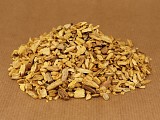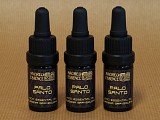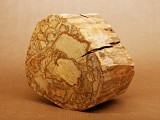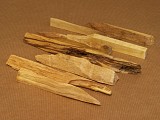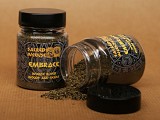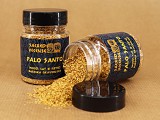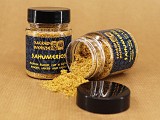Wood, Beads, 9 Mm, 25 Beads from Ecuador (SKU 5794)
This pack includes 25 hand carved Palo Santo beads made from aged aromatic heartwood. Known for its rich, woody scent and spiritual properties, Palo Santo is used in rituals for cleansing, grounding and energy balancing. These sustainably sourced beads are ideal for crafting small malas, bracelets or scent jewellery. More information can be found below.
Bead size: 9 mm.
| change currency | ||||||||||
| SKU | Part | Form | Size | Volume | Unit | Price | Qty
|
|||
|---|---|---|---|---|---|---|---|---|---|---|
| 5794 | wood | beads | 9 mm | 25 beads | 1 packet | $ 12.60 | ||||
| 5795 | wood | beads | 9 mm | 50 beads | 1 packet | $ 22.67 | ||||
| 5796 | wood | beads | 9 mm | 100 beads | 1 packet | $ 40.31 | ||||
Palo Santo Beads – Sustainably Sourced Aromatic Wood Beads (9 mm)
These natural Palo Santo beads are hand carved from the aromatic heartwood of the Palo Santo tree, known for its powerful spiritual and medicinal qualities. Measuring 9 millimetres each, the beads carry the signature warm, resinous scent that Palo Santo is cherished for. They are available in packs of 25, 50 or 100 pieces, making them ideal for crafting malas, bracelets, scent jewellery or ritual objects.
Palo Santo, meaning "Holy Wood" in Spanish, has been used in spiritual and healing traditions for thousands of years. While it is most closely associated with South American shamanic cultures, its uses span continents including Africa and Asia, where similar sacred woods are burned in ceremony. In the Amazonian tradition, Palo Santo is used to cleanse space, remove heavy energies, restore inner balance and deepen spiritual connection. The wood is often burned as powder or shavings over charcoal, with the fragrant smoke used to purify, relax or support healing work. Its aroma is soft, woody and sweet with subtle citrus and spice undertones that are grounding and emotionally calming.
The true potency of Palo Santo lies in its resin, which is only fully expressed after the tree has died naturally and aged for several years. When a tree falls, it begins a transformation. As the resin slowly migrates into the heartwood, it concentrates over time, enhancing the wood’s scent and energetic properties. This process typically takes four to ten years after the tree’s natural death. Only then is the wood harvested, ensuring the quality and potency of each piece. These beads are made from such aged heartwood, offering not only a rich aroma but also the energetic presence traditionally valued by healers and shamans.
In modern use, Palo Santo beads are popular for creating items that combine spiritual function with wearable beauty. When strung into malas or bracelets, they release a subtle scent as they warm against the skin or when gently handled. Many wear them during meditation, energy work or daily rituals as a grounding and protective presence. They can also be placed in pouches, sacred spaces or on altars to infuse the area with their soft, purifying aroma.
All wood used in these beads is ethically and sustainably sourced. Palo Santo trees are never cut down while living. Only wood from trees that have died naturally and aged in place is collected. This process is supervised and restricted under strict environmental guidelines, helping to protect both the tree species and the communities who rely on it.
Available pack sizes: 25 beads, 50 beads, 100 beads. Bead size: 9 mm
An extensive article on the Palo Santo tree and it's uses can be found here.
Other names: Bursera graveolens, Sisaya, Palo de la vida o Santo, Madeira Sagrada, Sacred Wood, Holy wood, St. Anthony`s wood, Palosanto, Malka Waki.
The incense, Palo Santo or "Holy Wood" (Bursera graveolens), originates from a short, dense tree that belongs to the Burseraceae or Torchwood family – a family that also includes myrrh and frankincense (Boswellia carteri). The Burseraceae family typically displays fragrant oleo-gum resins that come from the tree heartwood and are consequently burned as incense due to their ethereal odor (Langenheim 2003). Even though the wood is primarily used as incense or to extract essential oils, also the leaves, fruit, bark and roots are harvested and used.
The trees grow in dry, tropical forests, like the Andean region, and are native to Peru, Ecuador, Mexico, the Gallapagos Islands, and the Gran Chaco region (northern Argentina, Paraguay, Bolivia and the Brazilian Mato Grosso). The tree has a soft wood and only carries green leaves in the wet season; it grows preferably close to river banks, and is often inhabited by Brazilian fire ants that protect the holy tree from invaders.
The sweet woodsy Palo Santo scent comes from its aromatic ingredients that are composed of d-limonene, alpha-terpineol, carvone (Crowley 1964), phenolic compounds, flavonoids, quinones, antocyanidines, and also several unidentified agarofurans (Yukawa et al. 2004), which are found in the aged heartwood. Sesquiterpene viridiflorol is the main compound (~71%) contained in the holy Wood.
For those who love to experiment with the alchemy of combined scents, Palo Santo goes very well with the following incenses: Sweetgrass (Hierochloe odorata), White Sage (Salvia apiana) and Copal (Dacryoides peruviana).
Crowley KJ. J. Chem. Soc., 1964; 4254.
Yukawa C, Iwabuchi H, Kamikawa T, Komemushi S, Sawabe A (2004).Terpenoids of the volatile oil of Bursera graveolens. Flavour Fragr. J. 2004; 19: 565–570.
This item is not allowed in the following countries:
Taiwan
This is a natural product, used as incense or in perfumery, or as an ingredient of incense and other perfumery or potpourri preparations.
Some incense plants or products may have some history of other folklore purposes, but we offer this product for its use as incense. Not food grade, not for consumption.
Please read our Terms & Conditions before placing your order.

